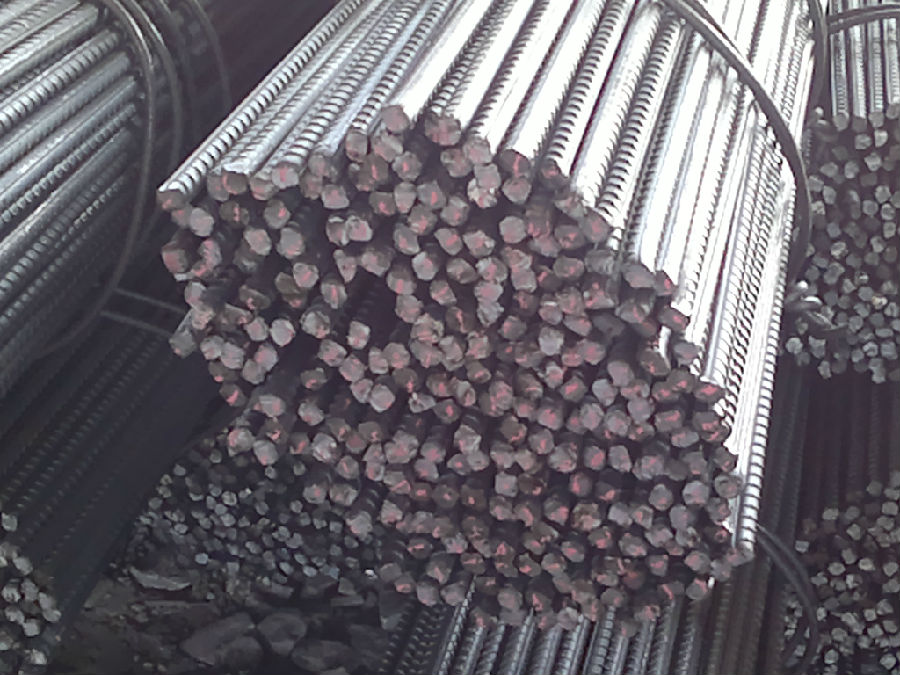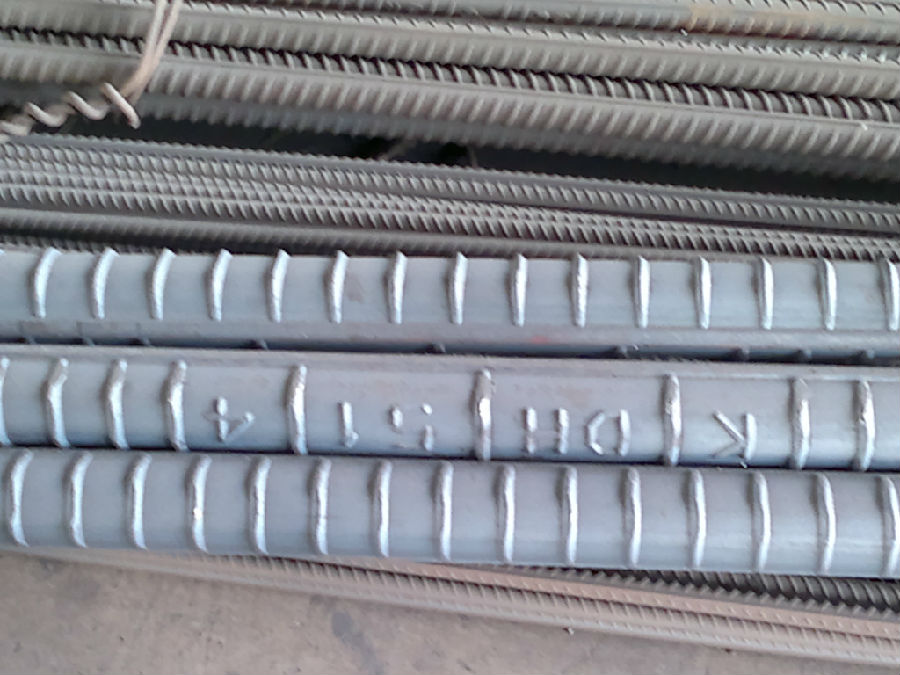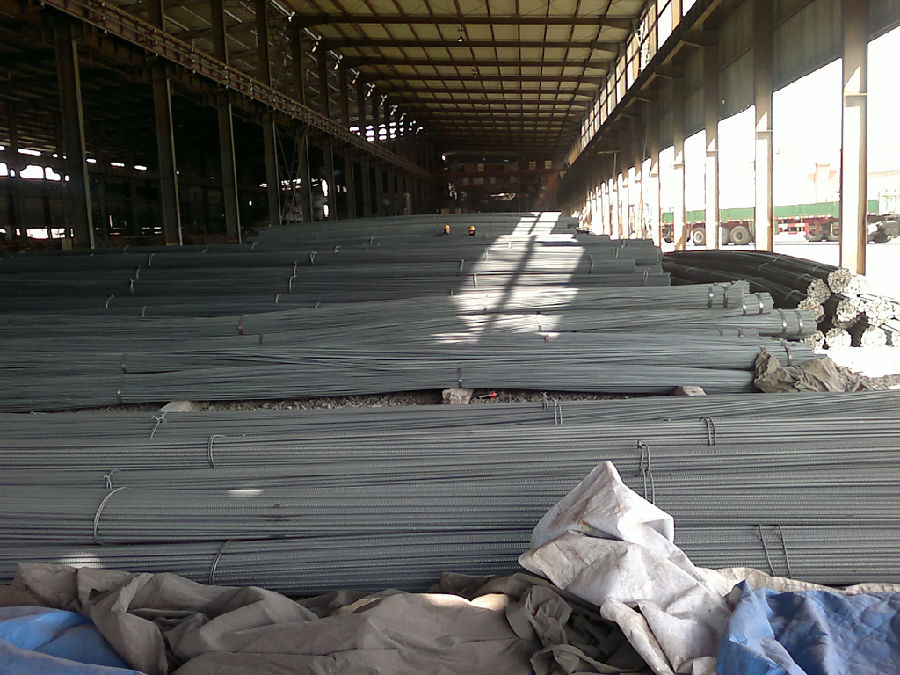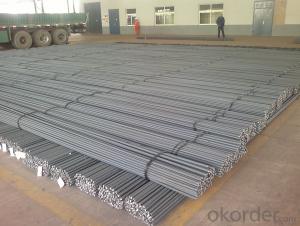Steel Rebar/Deformed Steel Bar / Iron Rods for Construction/Concrete
- Loading Port:
- Tianjin
- Payment Terms:
- TT or LC
- Min Order Qty:
- 100 m.t.
- Supply Capability:
- 30000 m.t./month
OKorder Service Pledge
OKorder Financial Service
You Might Also Like
OKorder is offering Steel Rebar/Deformed Steel Bar / Iron Rods for Construction/Concrete at great prices with worldwide shipping. Our supplier is a world-class manufacturer of steel, with our products utilized the world over. OKorder annually supplies products to African, South American and Asian markets. We provide quotations within 24 hours of receiving an inquiry and guarantee competitive prices.
Product Applications:
Steel Rebar/Deformed Steel Bar / Iron Rods for Construction/Concrete are ideal for structural applications and are widely usedthe construction of buildings and bridges, and the manufacturing, petrochemical, and transportation industries
Product Advantages:
OKorder's Steel Rebar/Deformed Steel Bar / Iron Rods for Construction/Concrete are durable, strong, and wide variety of sizes.
Main Product Features:
· Premium quality
· Prompt delivery & seaworthy packing (30 days after receiving deposit)
· Can be recycled and reused
· Mill test certification
· Professional Service
· Competitive pricing
Product Specifications:
Manufacture: Hot rolled
Grade:HRB400
Certificates: ISO, SGS, BV, CIQ
Packed: prproduct packed in bundles
Deformed Steel Bar | ||
Diameter (MM) | Cross Sectional Area (MM2) | Theorectical Weight (KG/M) |
6 | 28.27 | 0.222 |
8 | 50.27 | 0.395 |
10 | 78.54 | 0.617 |
12 | 113.1 | 0.888 |
14 | 153.9 | 1.21 |
16 | 201.1 | 1.58 |
18 | 254.5 | 2 |
20 | 314.2 | 2.47 |
22 | 380.1 | 2.98 |
25 | 490.9 | 3.85 |
28 | 615.8 | 4.83 |
32 | 804.2 | 6.31 |
36 | 1018 | 7.99 |
40 | 1257 | 9.87 |
Grade | Technical data of the original chemical composition (%) | |||||||
C | Mn | Si | S | P | V | |||
HRB400 | ≤0.25 | ≤1.60 | ≤0.80 | ≤0.045 | ≤0.045 | 0.04-0.12 | ||
Physics capability | ||||||||
Yield Strength(N/cm2) | Tensile Strength(N/cm2) | Elongation (%) | ||||||
≥400 | ≥570 | ≥14 | ||||||
FAQ:
Q1: Why buy Materials & Equipment from OKorder.com?
A1: All products offered byOKorder.com are carefully selected from China's most reliable manufacturing enterprises. Through its ISO certifications, OKorder.com adheres to the highest standards and a commitment to supply chain safety and customer satisfaction.
Q2: How do we guarantee the quality of our products?
A2: We have established an advanced quality management system which conducts strict quality tests at every step, from raw materials to the final product. At the same time, we provide extensive follow-up service assurances as required.
Q3: How soon can we receive the product after purchase?
A3: Within three days of placing an order, we will arrange production. The normal sizes with the normal grade can be produced within one month. The specific shipping date is dependent upon international and government factors, the delivery to international main port about 45-60days.
Q4: How many tons of steel products could be loaded in containers?
A4: Usually the steel products are delivered by bulk vessel because of the large quantity and the freight. However, there are no bulk vessel enter some seaports so that we have to deliver the cargo by containers. The 6m steel product can be loaded in 20FT container, but the quantity is changed according to the size, usually from 18tons to 25tons.
Images:



- Q:What are the guidelines for cutting and bending steel rebars on-site?
- The guidelines for cutting and bending steel rebars on-site typically include using appropriate tools such as a rebar cutter and bender, ensuring safety measures such as wearing protective gear, following the required dimensions and angles specified in the construction plans, and using proper techniques to achieve clean and accurate cuts and bends. It is crucial to follow local building codes, manufacturer's instructions, and industry best practices to ensure structural integrity and worker safety.
- Q:How do steel rebars affect the overall sustainability of bridge constructions?
- The overall sustainability of bridge constructions is greatly improved by the inclusion of steel rebars. Firstly, steel rebars play a crucial role in enhancing the longevity and durability of bridges. They reinforce concrete structures, ensuring that tensile and compressive forces are evenly distributed and minimizing the risk of cracks and structural failure. This results in a longer functional lifespan for the bridge, reducing the need for frequent repairs or replacements and ultimately decreasing material consumption and waste generation. Furthermore, the sustainability of bridge constructions is further enhanced by the high recyclability of steel rebars. Once a bridge reaches the end of its life cycle, the steel rebars can be easily removed and recycled. This reduces the demand for new steel production, conserving natural resources and reducing carbon emissions associated with manufacturing processes. Additionally, the recycling of steel rebars helps mitigate the environmental impacts of mining and extraction activities. In addition, the use of steel rebars enables the design of lighter and more efficient bridge structures. Steel is known for its high strength-to-weight ratio, allowing for the creation of slender and visually appealing bridge designs. By reducing the weight of the bridge, less material is required for construction, resulting in lower energy consumption and carbon emissions during manufacturing, transportation, and construction phases. Furthermore, lighter bridge structures place less strain on the supporting foundation, reducing the need for costly reinforcement measures. In conclusion, the inclusion of steel rebars positively impacts the overall sustainability of bridge constructions in various ways. They enhance durability, reduce the need for repairs or replacements, and minimize waste generation. The recyclability of steel rebars helps conserve natural resources, reduce carbon emissions, and mitigate environmental impacts. Additionally, the use of steel rebars allows for the design of lighter and more efficient bridge structures, resulting in lower energy consumption and associated carbon emissions.
- Q:What is the effect of overloading on steel rebars?
- The effect of overloading on steel rebars is that it can lead to their deformation or failure. Overloading refers to subjecting the rebars to loads or forces that exceed their designed capacity. This can cause the rebars to bend, crack, or break, compromising the structural integrity of the reinforced concrete. It is crucial to ensure that rebars are not subjected to excessive loads to prevent potential safety hazards and maintain the overall strength and durability of the structure.
- Q:How do steel rebars contribute to the structural integrity of a building?
- Steel rebars, also known as reinforcing bars, play a crucial role in enhancing the structural integrity of a building. These bars are embedded within concrete structures, such as beams, columns, and slabs, to provide tensile strength and prevent cracking or failure under load. By reinforcing the concrete, steel rebars help distribute and resist the forces acting on the structure, ensuring its stability and durability.
- Q:How do steel rebars affect the overall acoustic properties of a structure?
- Steel rebars, also known as reinforcement bars, play a significant role in the overall acoustic properties of a structure. The presence of steel rebars can have both positive and negative effects on the acoustic characteristics of a building or infrastructure. One of the primary ways steel rebars affect the acoustic properties is through their ability to transmit sound vibrations. Steel is a good conductor of sound, meaning that it can easily transmit sound waves. Therefore, when steel rebars are present in a structure, they can act as pathways for the transmission of sound, allowing it to travel more easily throughout the building. This can lead to increased noise levels and reduced acoustic privacy, as sound waves can travel through the steel rebars and reach different parts of the structure. On the other hand, steel rebars can also contribute to the overall sound insulation of a structure. When properly installed and integrated with other construction materials, such as concrete or acoustic insulation materials, steel rebars can help reduce the transmission of sound waves. The rigidity and mass of steel rebars can help dampen the vibrations caused by sound waves, thereby reducing the amount of sound that passes through the structure. This can enhance the acoustic comfort within the building, making it quieter and more suitable for various activities that require reduced noise levels. It is worth noting that the impact of steel rebars on the acoustic properties of a structure depends on various factors, such as the thickness and density of the surrounding construction materials, the arrangement and spacing of the rebars, and the overall design of the building. Additionally, the use of additional acoustic treatments, such as sound-absorbing panels or insulation, can further improve the acoustic performance of a structure by mitigating the negative effects of steel rebars. In conclusion, steel rebars have a significant influence on the overall acoustic properties of a structure. While they can facilitate the transmission of sound waves, they can also contribute to sound insulation when combined with appropriate construction materials and techniques. Proper design and implementation, along with the use of additional acoustic treatments, are crucial in achieving a desired acoustic environment in buildings and infrastructure where steel rebars are present.
- Q:Do steel rebars increase the overall weight of a structure?
- Yes, steel rebars do increase the overall weight of a structure. Rebars are typically added to reinforce concrete structures, providing tensile strength to counteract the concrete's weakness in handling tension forces. Steel rebars are made of steel, which is a dense and heavy material. When incorporated into a structure, the weight of the rebars adds to the total weight of the construction. However, the additional weight is usually negligible compared to the overall weight of the structure, especially in large-scale projects. The benefits of using steel rebars in terms of structural integrity and durability far outweigh the minimal increase in weight they contribute.
- Q:Can steel rebars be used in structures with limited construction timeframes?
- Yes, steel rebars can be used in structures with limited construction timeframes. Steel rebars are commonly used in construction due to their strength, durability, and ability to withstand high loads. Their quick installation process makes them suitable for projects with strict timelines, allowing for efficient and timely construction of structures.
- Q:What is the process of inspecting steel rebars for quality control?
- To ensure that steel rebars meet the required standards and specifications, the quality control inspection process encompasses various steps. Below is a general outline of the process: 1. Visual Inspection: Initially, the rebars undergo visual inspection to identify any visible defects such as cracks, surface imperfections, or irregular shapes and sizes. This can be done manually or by utilizing automated systems that employ image processing techniques to detect defects. 2. Measurement and Dimensional Inspection: The dimensions of the rebars, including length, diameter, and shape, are measured using calibrated instruments such as calipers, gauges, or laser-based devices. These measurements are then compared to specified tolerances to ensure compliance. 3. Chemical Analysis: A sample of rebars is taken and subjected to chemical analysis to determine the steel's composition. This involves measuring the levels of carbon, manganese, sulfur, phosphorus, and other elements. The results are then compared to the required chemical composition specified in the standards. 4. Mechanical Testing: The mechanical properties of the rebars, such as tensile strength, yield strength, elongation, and bendability, are crucial for construction purposes. Samples are extracted from the batch and tested in a laboratory using standardized tests, such as tensile testing machines, to ensure they meet the specified requirements. 5. Corrosion Resistance Testing: Since rebars are often exposed to harsh environmental conditions, assessing their resistance to corrosion is essential. This can be achieved through tests like salt spray testing or electrochemical methods, which measure the rebars' corrosion resistance and ensure their long-term strength. 6. Weldability Testing: If the rebars are intended for welding applications, their ability to form a strong and defect-free weld joint is assessed. This includes evaluating their weldability through visual inspection, bend tests, or even destructive testing of welded samples. 7. Documentation and Certification: Throughout the inspection process, detailed records of measurements, test results, and observations are documented. If the rebars pass all quality control tests, a certification or quality control report is issued, confirming that they meet the required standards and specifications. It is important to note that the specific inspection procedures may vary depending on the applicable standards, project requirements, and the type of rebar being inspected. Furthermore, these inspections can be conducted by internal quality control teams or independent third-party inspection agencies to ensure impartiality and accuracy of the results.
- Q:How do steel rebars improve the structural integrity of a building?
- Steel rebars, also known as reinforcement bars, play a crucial role in enhancing the structural integrity of buildings. They are used in concrete construction to provide strength, durability, and resistance to various forces that a structure may encounter. One key way steel rebars improve the structural integrity of a building is by increasing its load-bearing capacity. When concrete is reinforced with rebars, it becomes more capable of withstanding heavy loads and forces such as those generated by gravity, wind, earthquakes, or even dynamic loads from human activities. The rebars act as a reinforcement network, distributing the load more evenly throughout the structure, preventing excessive deflection, and minimizing the risk of structural failure. Moreover, steel rebars improve the tensile strength of concrete, which is traditionally weak in tension. Concrete is great at bearing compression forces but lacks the ability to effectively resist pulling or stretching forces. By incorporating rebars into the concrete, the combination of materials works together to withstand both compression and tension forces more efficiently. This prevents cracks and fractures from propagating in the concrete, as the rebars act as a support system that holds the structure together. Another advantage of using steel rebars is their resistance to corrosion. Steel is highly durable and can withstand harsh environmental conditions, reducing the risk of degradation over time. This ensures the longevity of the building's structural elements and decreases the need for costly repairs or replacements. Additionally, steel rebars provide flexibility in design and construction. They can be molded into various shapes and sizes to accommodate specific structural requirements, making it possible to optimize the distribution of reinforcement where it is needed most. This flexibility allows architects and engineers to design buildings that are both aesthetically pleasing and safe, without compromising on structural integrity. In conclusion, steel rebars significantly improve the structural integrity of buildings by increasing load-bearing capacity, enhancing tensile strength, resisting corrosion, and providing design flexibility. By reinforcing concrete, they ensure that structures are better equipped to withstand various forces and maintain their stability and safety over time.
- Q:How do steel rebars resist fatigue and creep?
- Steel rebars exhibit resistance to fatigue and creep by virtue of their inherent material properties and careful design considerations. Fatigue, the gradual weakening of a material caused by repeated cyclic loading, is effectively countered by the specific design of steel rebars. These rebars are purposely engineered to withstand fatigue through their exceptional tensile strength and ductility. The tensile strength of steel enables it to resist the stress imposed by cyclic loading, while its ductility allows it to deform without fracturing. This unique combination of properties equips steel rebars with the capability to endure numerous load cycles without experiencing failure. Moreover, the resistance of steel rebars to fatigue can be further fortified by employing various techniques, including heat treatment, surface coatings, and alloying. These methods serve to enhance the material's fatigue resistance and increase its longevity under cyclic loading conditions. On the other hand, creep refers to the gradual deformation of a material under constant sustained loading. Steel rebars effectively resist creep due to their high stiffness and resistance to plastic deformation. The stiffness of steel enables it to maintain its shape and resist deformation when subjected to sustained loads. Additionally, the resistance to plastic deformation prevents excessive stretching or elongation, which could lead to creep failure. To enhance the resistance of steel rebars to both fatigue and creep, proper design considerations play a crucial role. These considerations encompass factors such as appropriate reinforcement spacing, proper anchorage, and sufficient concrete cover to safeguard the rebars from external elements that may induce fatigue or creep. In conclusion, steel rebars offer resistance to fatigue and creep as a result of their high tensile strength, ductility, stiffness, and resistance to plastic deformation. By incorporating meticulous design considerations and potentially implementing supplementary techniques, steel rebars can withstand cyclic loading and sustained loads over extended periods, thereby ensuring their durability and structural integrity.
1. Manufacturer Overview |
|
|---|---|
| Location | |
| Year Established | |
| Annual Output Value | |
| Main Markets | |
| Company Certifications | |
2. Manufacturer Certificates |
|
|---|---|
| a) Certification Name | |
| Range | |
| Reference | |
| Validity Period | |
3. Manufacturer Capability |
|
|---|---|
| a)Trade Capacity | |
| Nearest Port | |
| Export Percentage | |
| No.of Employees in Trade Department | |
| Language Spoken: | |
| b)Factory Information | |
| Factory Size: | |
| No. of Production Lines | |
| Contract Manufacturing | |
| Product Price Range | |
Send your message to us
Steel Rebar/Deformed Steel Bar / Iron Rods for Construction/Concrete
- Loading Port:
- Tianjin
- Payment Terms:
- TT or LC
- Min Order Qty:
- 100 m.t.
- Supply Capability:
- 30000 m.t./month
OKorder Service Pledge
OKorder Financial Service
Similar products
New products
Hot products
Related keywords





























